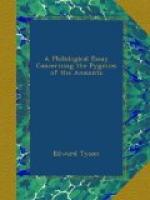Of stone structures built by fairies or little people for the use of others, may be mentioned the churches built by dwarfs in Scotland and Brittany, and described by Mr. MacRitchie, as also the two following instances, taken from widely distant parts of the globe. In Brittany, the dolmen of Manne-er Hrock (Montaigne de la Fee), at Locmariaquer, is said to have been built by a fairy, in order that a mother might stand upon it and look out for her son’s ship.[A] In Fiji the following tale is told about the Nanga or sacred stone enclosure:—“This is the word of our fathers concerning the Nanga. Long ago their fathers were ignorant of it; but one day two strangers were found sitting in the Rara (public square), and they said they had come up from the sea to give them the Nanga. They were little men, and very dark-skinned, and one of them had his face and bust painted red, while the other was painted black. Whether these were gods or men our fathers did not tell us, but it was they who taught our people the Nanga. This was in the old times, when our fathers were living in another land—not in this place, for we are strangers here."[B] It is worthy of note that the term “Nanga” applies not merely to the enclosure, but also to the secret society which held its meetings therein.[C]
[Footnote A: Flint Chips, p. 104.]
[Footnote B: Fison, Journ. Anthrop. Inst., xiv, 14.]
[Footnote C: Joske, Internat. Arch. f. Ethnographie, viii. 254.]
5. The little people make their dwellings either in the interior of a stone or amongst stones. I am not here alluding to the stones on the sides of mountains which are the doorways to fairy dwellings, but to a closer connection, which will be better understood from some of the following instances than from any lengthy explanation. The Duergas of the Scandinavian Eddas had their dwelling-places in stones, as we are told in the story of Thorston, who “came one day to an open part of the wood, where he saw a great rock, and out a little way from it a dwarf, who was horridly ugly."[A] In Ireland, in Innisbofin, co. Galway, Professor Haddon relates that the men who were quarrying a rock in the neighbourhood of the harbour refused to work at it any longer, as it was so full of “good people” as to be hot.[B] In England the Pixy-house of Devon is in a stone, and a large stone is also connected with the story of the Frensham caldron, though it is not clear that the fairies lived in the rock itself.[C] Oseberrow or Osebury (vulgo Rosebury) Rock, in Lulsey, Worcestershire, was, according to tradition, a favourite haunt of the fairies.[D] In another part of Worcestershire, on the side of the Cotswolds, there is, in a little spinney, a large flat stone, much worn on its under surface, which is called the White Lady’s Table. This personage is supposed to take her meals with the fairies at this rock, but what the exact relation of the little people to it as a dwelling-place may be, I have not been able to learn.




